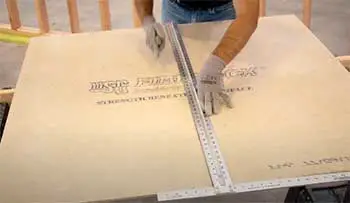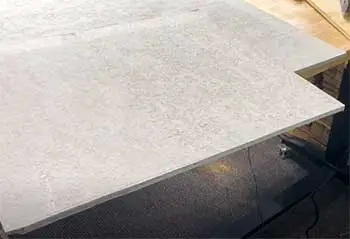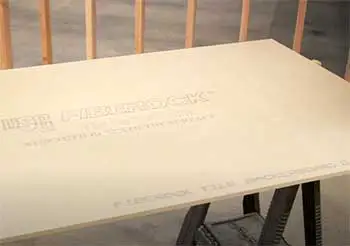When it comes to deciding on Fiberock or Cement Board for a home or commercial space, it depends a lot on the contractor. The basic difference between the two is that Fiberock is a gypsum-based board, whereas cement board is a cement-based product, as the name says.
It is quite common to get confused while picking between these two. This blog post intends to help you out regarding this matter by pointing out the differences between these two options.
So, without any further ado, let’s jump in.
A Quick Comparison Table
Just like all the other times, you will get to see the differences between Fiberock and Cement Board in brief. It would help you take the decision in the quickest way possible and save you time significantly.
| Specifications | Fiberock | Cement Board |
| The material of the product | Fiberock is made mostly of gypsum board. | Cement board is a cement-based product. |
| Weight | This is comparatively lightweight. | The Cement Board is heavier than Fiberock. |
| Being fragile | As it is mostly made of gypsum and is lightweight, it is very much fragile. | Cement board is harder due to the materials it has. |
| Moisture tolerance | It has less tolerance for moisture. | Cement Board is perfectly suited to moisture-exposed places. |
| Durability | It is less durable. | The Cement Board is more durable than the Fiberock and resistant to unfavorable environments. |
| Usage suitability | It is preferred for the inner environment of the building. | It can be well suited for both the inner and outer environment. |
| Cutting difficulties | It is easy to cut. | The Cement Board is not easy to cut. |
So, these are some notable differences between the Fiberock and the Cement board. However, if you still want to know about these differences in detail, then the next section is for you.
Key Differences Between Fiberock And Cement Board
By now you have known the basic differences in brief. Now, it is time to know about the differences between Fiberock and Cement Board in detail. Here you go.
- Product Material

The primary material of Fiverock and Cement Board is totally different.
The Gypsum board makes the Fiberock mostly as it has the dominant proportion.
On the contrary, cement board is for sure a cement-based product.
Naturally, due to the difference in the main material, the characteristics also differ for the two options.
- Weight of The Products
Due to the material of the product, Fiberock is comparatively lightweight than Cement Board. Cement board is made of mainly cement material, so it weighs more than the other alternative.
- Being Fragile
When picking between the two alternatives, Fiberock and Cement Board considering the frailness can be crucial. Fiberock is made of gypsum and is lightweight, so it is more fragile.
So, it must be placed in the proper place in your home or commercial space.
On the other hand, Cement Board is not as fragile as Fiberock.
- Moisture Tolerance
Fiberock is not friendly for the moisture-exposed environment. That is why most contractors tend to put it inside the home rather than outside of the home.
But Cement Board is perfectly suited for the moisture-exposed environment. So, it is okay to consider it for the external part of the home.
- The Durability Of Both Options
Fiberock is less durable in a harsh environment. Unlike Fiberock, Cement Board is more durable in an unfavorable environment. It is also mostly due to the difference in the primary material of both options.
- Usage Suitability

Due to the differences in their natures, both of the products are not appropriate for the same part of a house.
Fiberock is mostly intended for the internal portion of the house which is less vulnerable to the harsh environment.
On the other hand, Cement board is mostly suitable for the outside part of a house or an office space.
- Cost Comparison
Fiberock generally costs less than most cement backer boards. Here are some example price comparisons:
- 1/2″ Fiberock board: Approximately $0.40 – $0.60 per sq. ft.
- 1/2″ Cement board: Approximately $0.65 – $0.90 per sq. ft.
So Fiberock is 25-50% cheaper than cement board on average. Other factors like panel size can affect pricing as well.
- Cutting Difficulties
During the fixture sometimes the contractors also consider the difficulties during the cutting procedure. In that consideration, Fiberock seems to be the suited one as it is easier to cut during the work.
But as the Cement Board is not as fragile as the other alternative, it is not easy to cut.
Key Features And Benefits of Fiberock Backer Board:

- Water resistant: Fiberock has a water resistant acrylic coating that allows it to withstand water exposure for prolonged periods. It will not deteriorate or delaminate when exposed to water like plain drywall.
- Mold resistant: The acrylic coating also resists mold growth, an important feature for wet areas.
- Lightweight: At 2.5 lbs per square foot, Fiberock is lighter than most cement boards. This makes it easier to cut, carry, and install.
- Easy to score and snap: Fiberock can be cut easily with a utility knife. No power tools needed.
- Flexible: Fiberock is much more flexible than cement board. This allows it to be bent as needed to fit curved walls.
- Good fastener hold: The fiberglass mat reinforcement provides excellent screw and nail holding strength.
- Low dust: Cutting and handling produces less dust than cement board.
- Paintable: Fiberock can be painted to match surrounding surfaces.
The main downside to Fiberock is that it has very low fire resistance compared to cement board. It should not be used around fireplaces or other areas requiring a fire rating.
Key Features And Benefits of Cement Backer Boards Like Hardiebacker:
- Water durable: Cement board is not waterproof, but it is highly water durable and resistant to deterioration from moisture over time.
- Mold resistant: The alkaline concrete core resists mold growth.
- Rigid and strong: Cement board is rigid with high impact resistance. The concrete provides superior strength compared to Fiberock.
- Fire resistant: Cement board is non-combustible and has excellent fire resistance.
- Handles high temps: It can withstand heat better than Fiberock. Useful around fireplaces and stoves.
- Inorganic: Made from concrete so it won’t rot or degrade like wood-based boards.
- Stable: Doesn’t expand or contract with changes in temperature and humidity.
The downsides of cement board include:
- Heavy and rigid: It’s harder to cut, lift, and work with than lighter Fiberock boards.
- Harder to cut: Cement board requires carbide tipped scoring tools and power saws for cutting. More difficult than scoring and snapping Fiberock.
- Not as water resistant: The concrete is water durable but not considered as water resistant as Fiberock.
- Can’t be bent: Low flexibility makes cement board harder to work with on curved surfaces.
- Higher cost: Cement board is generally more expensive than Fiberock.
- Dusty: Cutting and handling produces a lot of concrete dust.
Now that we’ve compared the key features and differences, let’s look at the ideal applications for Fiberock and cement backer boards.
Ideal Applications for Fiberock
Here are the types of applications where Fiberock really shines:
- Tub and shower surrounds – The water resistance and mold resistance make Fiberock ideal for tub/shower walls and backings. It can withstand prolonged moisture.
- Bathrooms – An excellent choice for bathroom walls and floors that will be regularly exposed to moisture. Performs well as a substrate for bath and shower tile.
- Kitchen backsplashes – Works well as a backer board for kitchen tile backsplashes which can be prone to grease, food splashes, and moisture.
- Laundry room tile – Fiberock stands up well to detergents, slop sink splashes, and other wet conditions common in laundry rooms.
- Entryways, mudrooms – For tile flooring in entryways and mudrooms where moisture resistance is important.
- Curved walls and surfaces – The flexibility of Fiberock allows it to be bent to fit curved or irregular shaped surfaces.
- Renovation projects – Lightweight and easy to cut making Fiberock a good choice for renovations and remodeling projects.
Ideal Applications for Cement Board

Here are the types of applications where cement board is most often used:
- Wet areas – Like Fiberock, cement board is well-suited to bathrooms, kitchens, laundries, and other areas prone to moisture.
- Steam showers and saunas – Cement board can withstand prolonged hot, humid and damp conditions.
- Heated subfloors – Ideal underlayment for radiant heat flooring because it can handle higher temperatures.
- Fireplace surrounds – The fire resistance makes cement board the top choice around fireboxes and fireplaces.
- Outdoor kitchens – Withstands weather exposure better than Fiberock. Good for outdoor tile backsplashes.
- Floor tile subfloor – On floors, cement board provides a very durable, rigid substrate for floor tile.
- Shower pans – Cement board makes a great pre-slope or substrate under waterproof shower pan liners.
- High traffic areas – The rigid strength of cement board makes it suitable for floors that will receive heavier traffic.
So in summary, cement board is the better performer for fire-related applications, outdoor uses, and heavy duty installations like subfloors. Fiberock is preferable for indoor, dry applications where its lighter weight and water resistance provide an advantage.
Which Backer Board Is Better For You?
Here comes the question that you have been waiting for. So, which one is going to be the appropriate one for you?
The answer to this question depends largely on your need and preference. But in most cases, the contractor of the home would pick the suitable option for you considering the need of your home.
When you are working on the exterior section of the house, then it would be better to go for the Cement Board. Similarly, while working on the interior portion of the house, it is more likely to pick the Fiberock.
But when you are more focused on the durability and longevity of the product and taking it as a long-term investment, then you can go with the Cement Board.
Frequently Asked Questions (FAQs)
Fiberock provides support for carpeting, ceramic tile, hardwood, and some other ways in the home or other commercial spaces. It is a water-resistant material but a bit fragile due to the Gypsum in it.
Yes, it is good for the places where there needs to be some sort of resistance from mold and moisture. But it may need to be changed after a few years.
The main difference between Fiberock and Durock is that Durock is more moisture-resistant. On the contrary, Fiberock is more fragile and easier to cut.
Yes, Fiberock can be used for walls for sure, but it is not entirely suitable for the shower wall. Durock seems to be more suitable for that purpose.
Wrapping Up
Fiberock and Cement Board, while picking between these two, you need to consider some aspects. Fiberock is a great option for most tile installations, but if you live in an area with high water exposure or have a lot of foot traffic, Cement Board may be your best option.
It’s more durable than Fiberock, and because it’s waterproof, it doesn’t need a moisture barrier to protect against water damage. I am sure you are going to pick the suitable one for you. Cheers!
